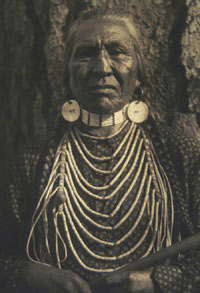Journey to the Bitterroot Valley
Who are the Salish?
Buying Salish Horses
The Salish Remember Lewis and Clark
| | |
Who are the Salish?
Erroneously called “Flatheads” (probably because the sign gesture for them suggested they flattened the sides of their head), the Bitterroot Valley Salish are part of a cluster of northwestern hunting peoples who speak closely related languages. Frightened by well-armed Blackfeet raiders from the east, and without a reliable source of European trade goods, the Salish leaders quickly decided to help the Americans. They traded fresh horses for sick ones and directed the expedition to a trail leading west over the Bitterroots.
In North American Indian Portfolio, Edward Curtis included
a Salish description, handed down in oral history, of their meeting with the
Corps of Discovery.
"The two captains advanced and shook hands with the chief, who
commanded his people to refrain from any evil-doing toward them. The white
men removed the pack-saddles from their horses and sat down on the ground.
The chief said: 'They have no robes to sit on. Some Indians have stolen
them. Bring them robes.' Buffalo-skins were brought, but, instead of sitting
on them, the white men threw them about their shoulders. One of their men
had a black face, and the Indians said among themselves: 'See, his face
is painted black! They are going to have a scalp-dance.'"
Nine Pipes, photographed by Edward Curtis in 1907, was a descendant
of the Salish band that helped the Corps of Discovery through the mountains.
Edward S. Curtis. “Portrait of Nine Pipes (Flathead Leader),” in North
American Indian Portfolio, 1907-1930.
|

| Click to Enlarge | Newberry Library |
|

